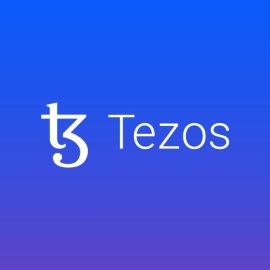- Aenean bibendum tempor lectus
- Vestibulum ultricies
- Nunc consectetur urna quis elit
- Aenean bibendum tempor lectus
- Vestibulum ultricies
- Nunc consectetur urna quis elit
| General | Social Media | Technical | Cookies | ||||
|---|---|---|---|---|---|---|---|
| Founder | Layer 2 | Coockies | |||||
| Location | Discord | Web | Contact Info | ||||
| No. Coins | Youtube | Mobile | Identifier | ||||
| Fees | Hedgies | Age Limit | |||||
| Leverage | Quora | Merch | ID Verify | ||||
Tezos Review
An introduction to Tezos?
Tezos (XTZ) is a self-updatable open source blockchain platform designed to build and host decentralized applications. Tezos stakeholders are responsible for driving upgrades to the protocol, including changes to the governance process itself. The native digital token is known as tezzie or Tez. Tezos ICO was one of the biggest ICOs in history, as it raised $232 million in 2018. Although governance and legal issues have delayed the open source project until 2020, they have been resolved and Tezos has gained traction thanks to the popularity of its staking mechanism. Interested in Tezos (XTZ), but don’t know what it is or where to start? No problem. This guide is designed to teach you everything you need to know about the project and prepare you for the most comfortable trading experience in the market.
What is Tezos?
Tezos was created as a cryptocurrency that allows anyone holding their XTZ tokens to vote on any future changes to the network’s rules. When consensus is reached on these rule changes, the software automatically updates the rules for all nodes in the network. This essentially gives the power to put the future of Tezos in the hands of its users. By adopting this operating system, the network has the advantage of higher user satisfaction, which almost eliminates the possibility of a hard fork. The entry of Tezos is revolutionary because its new model divides cryptocurrencies into two camps , those with “on-chain governance” and those with “off-chain governance”. This new and unique idea has generated a lot of public interest in Tezos, as evidenced by the more than successful series of financings in 2017.
How does Tezos work?
While Tezos offers similar functionality to other cryptocurrencies, its operating system is very different. The Tezos blockchain can be divided into two separate parts:
- Network Shell: The part of code that handles transactions and administrative operations that changes based on user votes.
- Network Protocol: Part of the code that sends suggestions to the shell for inspection.
Tezos uses a variant of the classic Proof of Stake (PoS) consensus mechanism called Liquid Proof of Stake (LPoS). This mechanism works by its users staking, or in Tezos’ case, “baking” XTZ. To become a baker, a single node is required to bake 8,000 XTZ tokens. Bakers play an important role in blockchain governance by voting on code changes proposed by developers.
History of Tezos
In 2014, Arthur Breitman and Kathleen Breitman initiated the Tezos project alongside a group of core developers. The company operates from Switzerland. In a span of 14 days, the Tezos initial coin offering (ICO) garnered a staggering $232 million by receiving investments in Bitcoin and Ether. Shortly after this record-breaking ICO, Tezos bumped into numerous management issues. The company that owned Tezos, DLS (Dynamic Ledger Solutions), was not the one to hold the ICO proceeds. Rather, a new company called Tezos Foundation held all the funds. Problems arose when the head of the Tezos Foundation refused to release the funds to the co-founders of Tezos.
What is special about Tezos?
A primary objective of Tezos is to transform into a blockchain that can establish the best reward structure in the world. A key contrast between Tezos and other digital currencies is its dual characteristic of being decentralized and self-governing. The distinctiveness of Tezos is significantly attributed to its automatic upgrades. network participants can conveniently cast their vote in favor of or against the suggested modifications, thereby making it an ideal platform for crypto enthusiasts.
Tezos security
Tezos makes use of a decentralized blockchain network, that means that there may be no primary database or a single point of failure. Even if a hacker manages to discover a way, no amendments may be made without previous approval from the stakeholders’ consensus. Tezos additionally makes use of cryptographic encryption to hold all consumer information secure It operates a custom designed model of Proof of Stake (PoS) this is constructed to permit users more flexibility transferring their stake from node to node, therefore encouraging more honorable behavior from the delegated baker nodes.
How to use Tezos
Although the Tezos blockchain has not been fully utilized, it has still experienced some level of acceptance. This project could be fascinating to developers who are seeking to introduce decentralized applications. Fully-functional applications have already been developed on the Tezos platform, such as tzBTC and Tezsure projects.Tezos is currently primarily used as a staking currency. This is attractive because it allows stakers (or “bakers” in Tezos) to passively generate more Tezos XTZ tokens.In addition, it can also be used as a speculative investment tool and payment instrument.
Tezos Wallet
The type of Tezos (XTZ) wallet you choose will most likely depend on what you plan to use it for and how much you need to store.Hardware wallets or cold wallets offer the most secure options with offline storage and backups. Ledger and Trezor hardware wallets provide storage and staking solutions for XTZ. However, hardware wallets may require bit more of a learning curve and are a more expensive option. As such, they may be better suited to storing large amounts of XTZ for advanced users.Software wallets offer another option, they are free and easy to use. They can be downloaded as smartphone or desktop apps and can be custodial or non-custodial. With custody wallets, private keys are managed and stored by the service provider on your behalf. Non-custodial wallets use a secure element on your device to store private keys. Although convenient, they are considered less secure than hardware wallets and may be better suited for small-volume XTZ or more novice users.
Final words
Tezos is a firmly established digital currency that has faced and overcome various challenges. Compared to other blockchains, Tezos eliminates hard forks or blockchain splits by using a blockchain-based governance mechanism that adopts and implements protocols chosen by voting in proportion to users’ economic stake.
It presents a unique value proposition for governance, which numerous investors may find appealing. If we add that Tezos is a blockchain capable of hosting decentralized applications, we can see why this cryptocurrency is so popular among crypto enthusiasts.

